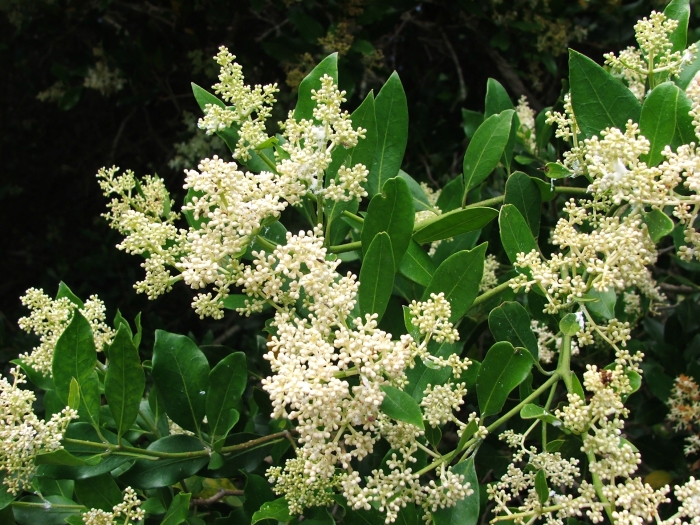Black Ironwood
(Olea capensis)
Black Ironwood (Olea capensis)
/
/

Abu Shawka
Public domain
Image By:
Abu Shawka
Recorded By:
Copyright:
Public domain
Copyright Notice:
Photo by: Abu Shawka | License Type: Public domain | License URL: https://creativecommons.org/public-domain/ | Uploader: Abu Shawka | Publisher: Wikimedia Commons | Title: Olea_capensis_Ironwood_tree_flowers.JPG | Notes: |




















































Estimated Native Range
Summary
Olea capensis, commonly known as Black Ironwood, is an evergreen tree native to the Afromontane forests, coastal forests, and riverine forests of Africa, as well as the Indian Ocean Islands. It can grow as a bushy shrub or a small to medium-sized tree, typically reaching up to 10 meters (33 ft) in height but occasionally soaring to 40 meters (130 ft) in ideal conditions. The bark of Black Ironwood is light grey and becomes dark grey with vertical fissures as it ages, with a characteristic blackish gum exuding from bark wounds. The leaves are light to dark green and glossy on the upper surface, with a paler green underside and often a purplish petiole. Its flowers are white or cream, sweetly scented, small, and found in many-flowered axillary or terminal heads; they are bisexual and typically bloom in spring. The Guinness Book of World Records recognizes Black Ironwood for having the world’s heaviest wood.
Black Ironwood is valued for its hard, dense timber and is often used in heavy construction, flooring, and fine furniture. Its drought tolerance and low water requirements make it suitable for xeriscaping and gardens with poor soil. It thrives in full sun and requires soils with medium drainage. While it is not commonly grown in cultivation outside its native range, it can be an attractive ornamental tree with its glossy foliage and fragrant flowers. However, due to its dense wood, it can be difficult to work with and may require specialized tools. Gardeners should be aware that the tree’s heavy wood can pose challenges if it needs to be removed or pruned.CC BY-SA 4.0
Black Ironwood is valued for its hard, dense timber and is often used in heavy construction, flooring, and fine furniture. Its drought tolerance and low water requirements make it suitable for xeriscaping and gardens with poor soil. It thrives in full sun and requires soils with medium drainage. While it is not commonly grown in cultivation outside its native range, it can be an attractive ornamental tree with its glossy foliage and fragrant flowers. However, due to its dense wood, it can be difficult to work with and may require specialized tools. Gardeners should be aware that the tree’s heavy wood can pose challenges if it needs to be removed or pruned.CC BY-SA 4.0
Plant Description
- Plant Type: Tree
- Height: 16-21 feet
- Width: 10-16 feet
- Growth Rate: Moderate
- Flower Color: White
- Flowering Season: Spring, Summer
- Leaf Retention: Evergreen
Growth Requirements
- Sun: Full Sun
- Water: Medium, High
- Drainage: Medium
Common Uses
Bee Garden, Bird Garden, Butterfly Garden, Fragrant, Low Maintenance
Natural Habitat
native to the Afromontane forests, coastal forests, and riverine forests of Africa, as well as the Indian Ocean Islands
Other Names
Common Names: Ijzerhout
Scientific Names: , Olea capensis, Olea cassinifolia,
GBIF Accepted Name: Olea capensis L.